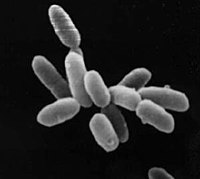
Photo from wikipedia
Optical density (OD) measurement is the standard method used in microbiology for estimating bacterial concentrations in cultures. However, most studies do not compare these measurements with viable cell counts and… Click to show full abstract
Optical density (OD) measurement is the standard method used in microbiology for estimating bacterial concentrations in cultures. However, most studies do not compare these measurements with viable cell counts and assume that they reflect the real cell concentration. Burkholderia thailandensis was recently identified as a polyhydroxyalkanoate (PHA) producer. PHA biosynthesis seems to be coded by an orthologue of the Cupriavidus necator phaC gene. When growing cultures of wildtype strain E264 and an isogenic phaC- mutant, we noted a difference in their OD600 values, although viable cell counts indicated similar growth. Investigating the cellular morphologies of both strains, we found that under our conditions the wildtype strain was full of PHA granules, deforming the cells, while the mutant contained no granules. These factors apparently affected the light scattering, making the OD600 values no longer representative of cell density. We show a direct correlation between OD600 values and the accumulation of PHA. We conclude that OD measurement is unreliable for growth evaluation of B. thailandensis because of PHA production. This study also suggests that B. thailandensis could represent an excellent candidate for PHA bioproduction. Correlation between OD measurements and viable cell counts should be verified in any study performed with B. thailandensis.
Journal Title: Canadian journal of microbiology
Year Published: 2020
Link to full text (if available)
Share on Social Media: Sign Up to like & get
recommendations!